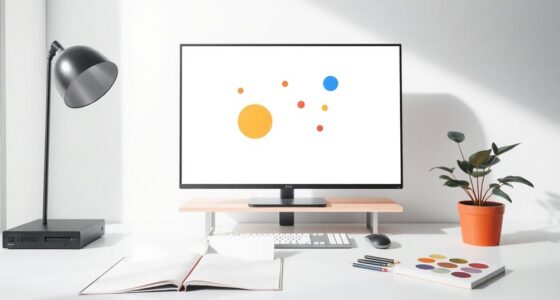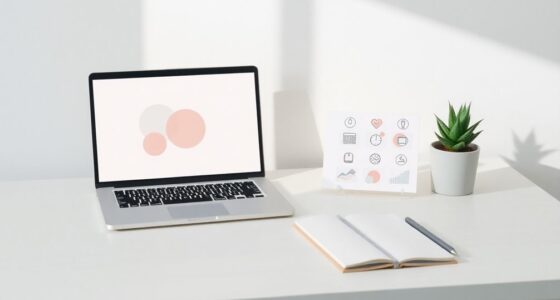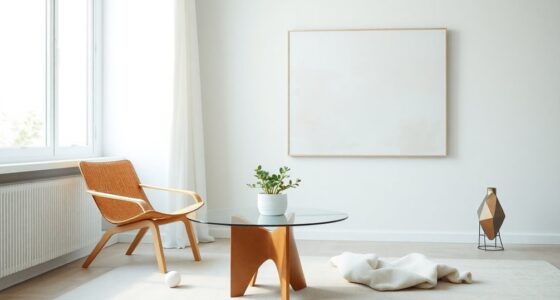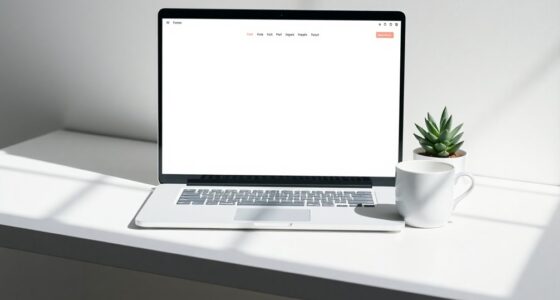Digital minimalism and UX design come together to enhance your mental well-being. By focusing on essential features and reducing cognitive load, you can enjoy a more intentional tech experience. Minimalist UX design utilizes clear typography and negative space to minimize distractions and promote engagement. Control over notifications helps prioritize what matters most. Embracing natural elements can elevate tranquility. Discover how these principles can transform your digital life and lead to improved functionality and aesthetics.
Key Takeaways
- Minimalist UX design enhances user engagement by prioritizing essential features and eliminating visual clutter for improved focus and usability.
- Incorporating negative space and a limited color palette supports visual clarity, reducing cognitive load and fostering a better user experience.
- Effective notification control in minimalist design minimizes distractions, allowing users to prioritize essential information and maintain mental well-being.
- Utilizing natural elements in UX design contributes to a calming atmosphere, enhancing user satisfaction and promoting healthier technology habits.
- Future research may explore richer interfaces that embrace simplicity, integrating haptic feedback and personalized AI-driven experiences for users.
Understanding Digital Minimalism

As you navigate the complexities of modern technology, understanding digital minimalism can help you reclaim your focus and mental well-being. This philosophy advocates for the intentional and limited use of technology, emphasizing what truly matters in your digital life.
Minimalism in UX design reduces cognitive overload by presenting only essential features, allowing you to engage with digital products meaningfully. By adopting clean user interfaces, you'll find that your productivity improves and frustration diminishes.
Instead of mindlessly scrolling, you'll cultivate healthier technology habits that foster mindful engagement. Continuous user feedback is vital in refining these minimalist approaches, ensuring they effectively address your core needs and pain points.
Embracing digital minimalism ultimately empowers you to create a balanced relationship with technology. Additionally, incorporating natural materials into your physical environment can enhance your overall sense of well-being and focus.
Principles of Minimalist UX Design
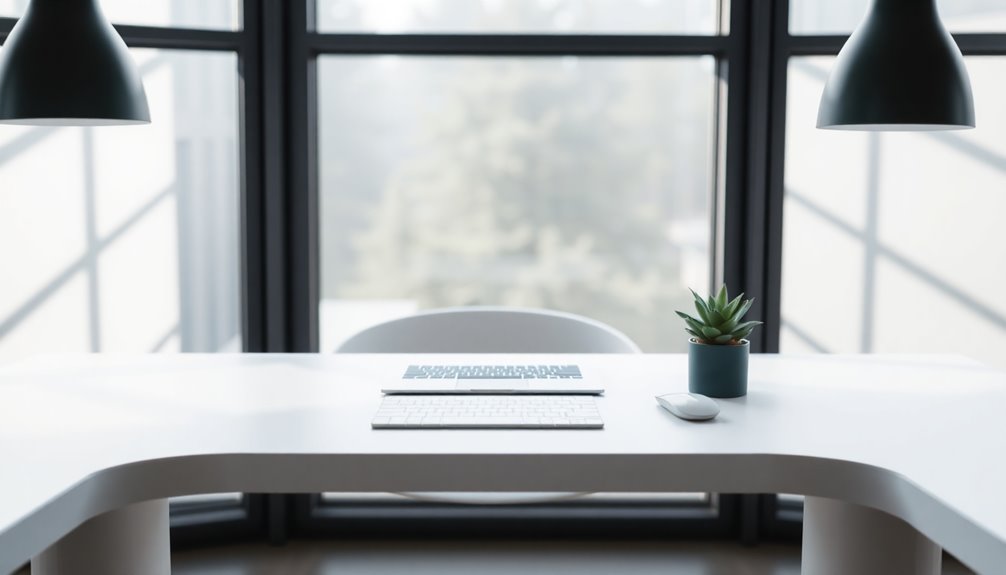
Digital minimalism lays the groundwork for effective minimalist UX design by encouraging a focus on what truly matters. To create a seamless experience, prioritize essential features and content while eliminating visual clutter.
Use clear typography to enhance readability, ensuring users can quickly comprehend information. Embrace negative space as a crucial element, allowing your design to breathe and preventing information overload.
A limited color palette helps maintain visual clarity and consistency. These design principles not only guide user interaction but also balance form and function, keeping excessive graphics and animations at bay. Additionally, incorporating natural elements can further enhance user experience by promoting a sense of calm and tranquility.
Reducing Cognitive Load in User Experiences
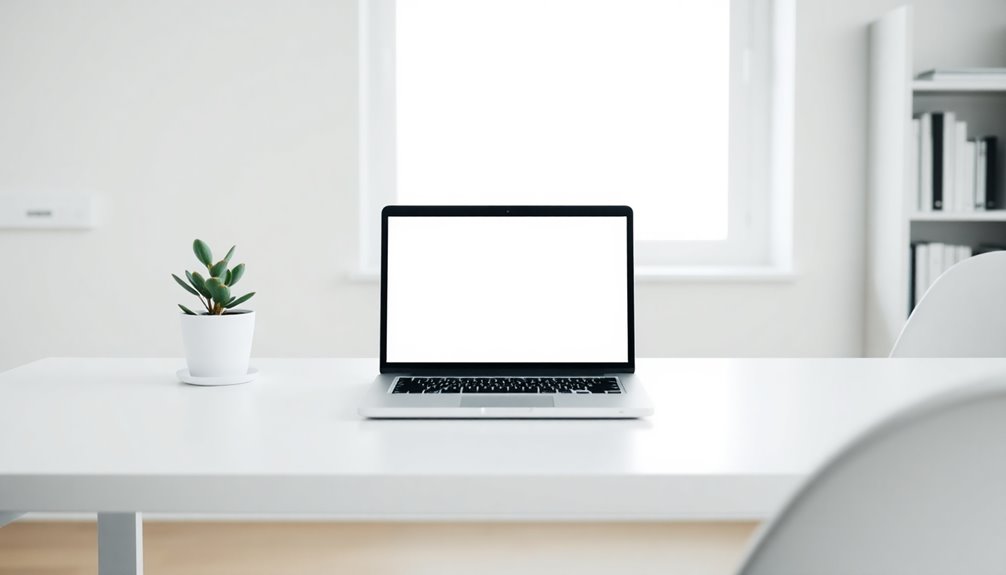
How can you create a user experience that feels effortless and intuitive? Start by focusing on reducing cognitive load. Use clear labeling and simple icons to guide users through your interface without confusion.
Break complex tasks into manageable steps, making decision-making straightforward and enhancing satisfaction. Incorporate ample whitespace in your design; it emphasizes essential content and gives users mental breathing room to process information effectively.
Limit notifications to only the most important information to cut down on information overload, helping users stay focused on what matters.
Finally, gather continuous user feedback to refine your minimalist design. This guarantees that your strategies for reducing cognitive load align with actual user needs and preferences, creating a more engaging experience. Additionally, consider the mental and emotional benefits of a decluttered interface, as it can enhance user satisfaction and foster a more productive environment.
The Role of Notifications in Minimalist Design
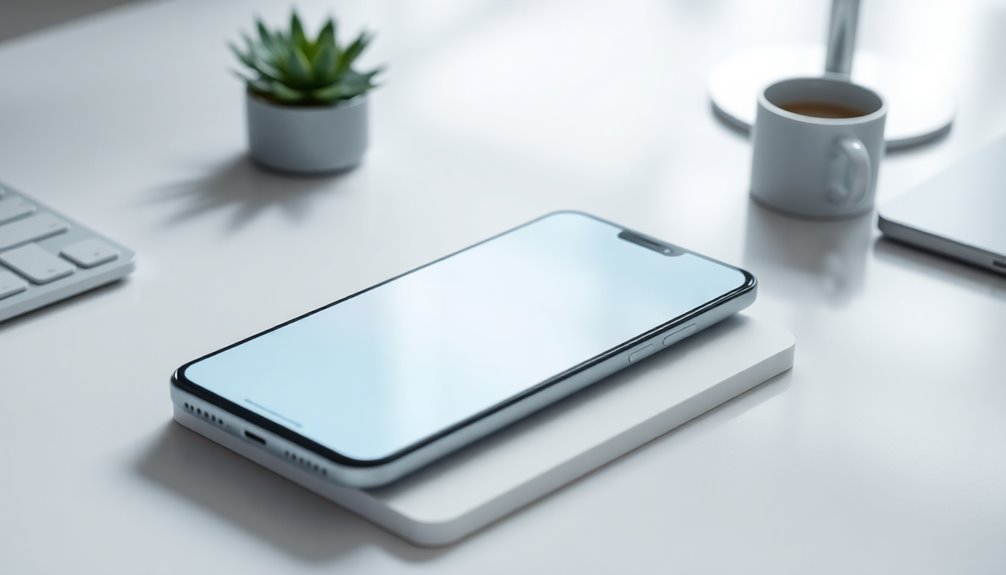
In minimalist design, controlling notifications is essential for maintaining your focus and reducing distractions.
By customizing your notification preferences, you can filter out unnecessary updates and manage information overload more effectively.
This streamlined approach not only enhances your experience but also supports your mental well-being by minimizing constant digital demands. Additionally, employing SEO-focused online courses can further improve your understanding of how to create a distraction-free digital environment.
Importance of Notification Control
Why do notifications often feel like an endless barrage? It's because, without proper notification control, you face constant distractions that pull your attention away from what matters.
In minimalist design, the goal is to minimize these interruptions, conveying only essential information. This helps you combat information overload, allowing for a more focused and peaceful user experience.
Excessive notifications can increase cognitive load and frustration, which UX design seeks to alleviate. By prioritizing crucial communications, minimalist design fosters healthier relationships with technology, promoting mindful engagement.
When you embrace effective notification control, you reclaim your time and reduce anxiety linked to constant digital demands, ultimately enhancing your overall experience. Moreover, recognizing signs of stagnation in your digital habits can inspire you to make meaningful changes that enhance your productivity and well-being.
Customization for User Preferences
While you navigate your digital landscape, customization of notifications becomes essential for tailoring your experience.
In minimalist design, prioritizing important information helps reduce distractions, aligning with the principles of digital minimalism. By minimizing notifications, you enhance your focus and reduce cognitive overload, creating a more peaceful user experience that respects your time and attention.
Effective minimalist designs use clear labeling and easy-to-understand icons, allowing you to quickly discern vital alerts without feeling overwhelmed.
Research shows that when you can customize notification preferences, user satisfaction increases and frustration diminishes. By limiting notifications to convey only essential information, designers encourage mindful engagement, helping you interact with technology in a more purposeful and intentional manner. Additionally, incorporating self-care practices into your routine can further enhance your overall well-being while using digital platforms.
Reducing Information Overload
Notifications can easily overwhelm you, drowning out essential information with an avalanche of alerts.
To embrace minimalism in UX design, you need to focus on reducing information overload. Limiting notifications not only lessens your cognitive load but also enhances user satisfaction.
Here are a few ways to create a more peaceful digital environment:
- Prioritize essential alerts that truly matter.
- Implement customizable notification preferences to fit your unique needs.
- Use clear labeling and icons for easy recognition.
Additionally, understanding user consent management can help you tailor notifications to better suit user preferences and reduce unnecessary distractions.
Strategies for Implementing Digital Minimalism
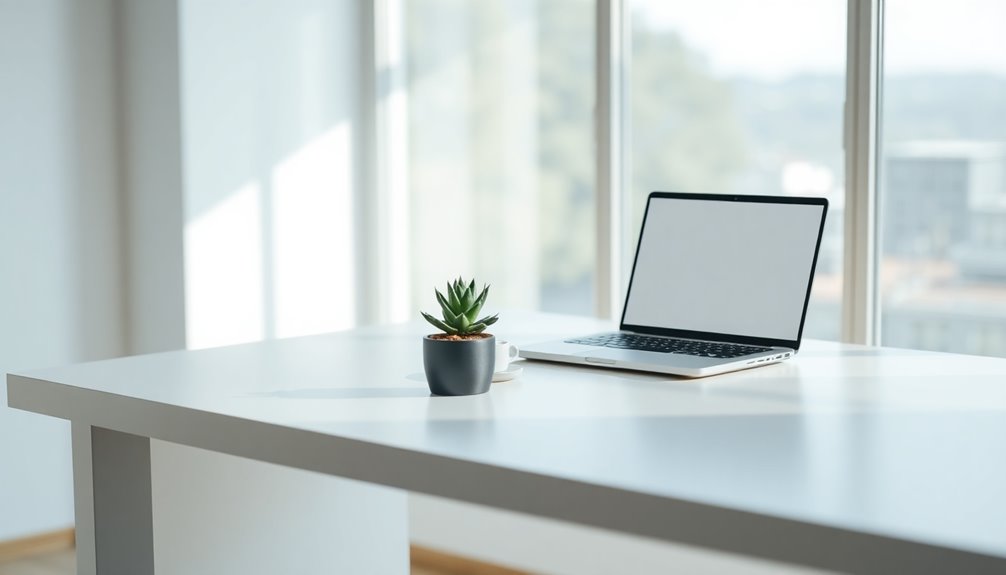
To effectively implement digital minimalism, start by prioritizing essential features using the MoSCoW method—this helps streamline user experiences and cut out distractions.
Conduct user research to identify core needs and pain points, ensuring your design focuses on functionality while minimizing cognitive load.
Conducting user research reveals essential needs and pain points, allowing designs to prioritize functionality and reduce cognitive load.
Encourage mindful engagement by providing usage statistics and reminders for users to take breaks, fostering a balanced relationship with technology.
Reducing notifications to convey only vital information allows users to customize their preferences, helping maintain focus and reduce information overload.
Finally, continuously collect and analyze user feedback to refine your minimalist design approach, ensuring that user experiences remain efficient and satisfying. Additionally, leveraging insights from decentralized governance models can enhance user engagement by promoting community-driven design decisions.
Case Studies of Successful Minimalist UX
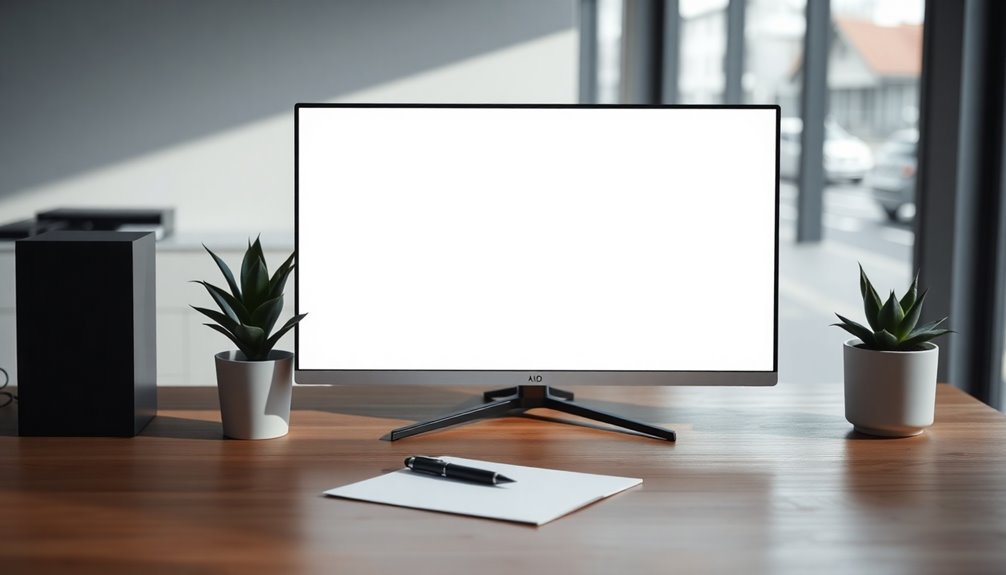
As you explore the impact of minimalist UX design, you'll find compelling case studies that showcase its effectiveness across various platforms.
- Google Search: Its simple layout prioritizes core functionality, enhancing user experiences and satisfaction.
- Headspace App: The soothing color palette and straightforward navigation reduce cognitive load, focusing on essential features like guided meditations.
- Airbnb's Redesign: The clean aesthetic integrates storytelling elements and visual cues to improve navigation and engagement.
These examples highlight how minimalism in UX design leads to streamlined functionality and reduced visual clutter.
Users enjoy improved focus and higher conversion rates, proving that prioritizing essential features can create a more intuitive user experience. Additionally, minimalist design can foster self-image and confidence, making it a powerful tool in creating appealing digital environments.
Minimalist design isn't just about aesthetics; it's about enhancing usability and satisfaction.
The Impact of Minimalist UX on Mental Well-Being

Minimalist UX design doesn't just enhance usability; it also positively influences mental well-being. By embracing minimalism, you create a user experience that promotes mindful engagement, steering you away from mindless scrolling.
Clean interfaces reduce cognitive load, which helps alleviate frustration and anxiety from complex digital environments. Research shows that when designs prioritize essential features and limit visual clutter, they enhance user satisfaction, creating a calming and efficient experience.
Clean interfaces lower cognitive load, easing frustration and anxiety while enhancing user satisfaction through minimalist design principles.
Simplifying interactions and limiting notifications respect your attention, contributing to a more peaceful user experience. This approach reduces information overload and stress, fostering a healthier relationship with technology. Additionally, just as regular maintenance of an air purifier can improve air quality and reduce stress, maintaining a clean digital interface can similarly enhance your mental clarity.
Continuous user feedback in minimalist UX helps refine solutions to meet your core needs, ultimately promoting your mental well-being.
Balancing Functionality and Aesthetics
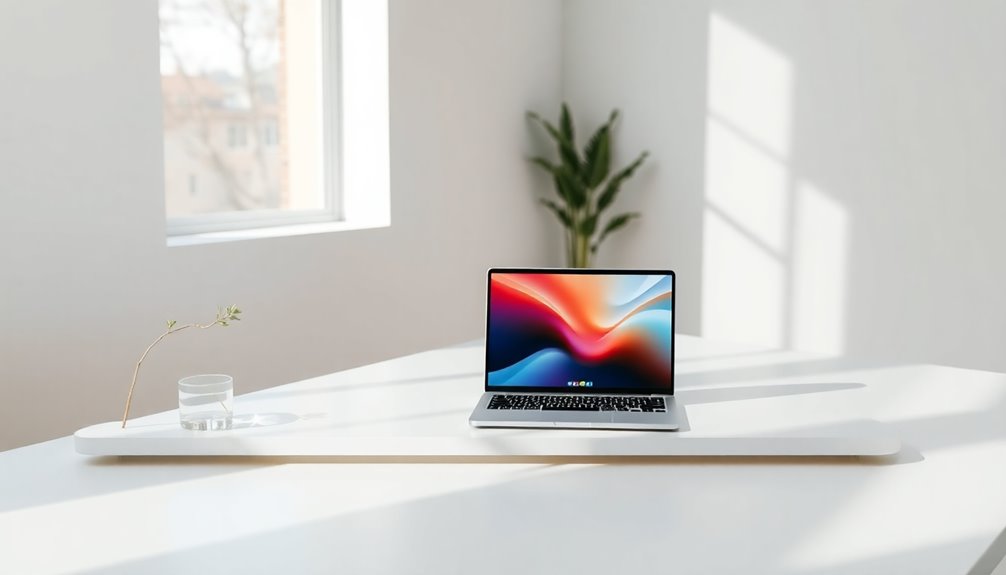
While achieving a harmonious blend of functionality and aesthetics in UX design may seem challenging, it's essential for creating a positive user experience. You need to prioritize essential features while ensuring your interface remains visually appealing and clutter-free.
Effective minimalist designs use ample whitespace and clear typography to enhance readability, guiding users through their tasks.
Consider these key points:
- Utilize user research to understand pain points.
- Apply the MoSCoW method to prioritize functionality.
- Gather continuous feedback to refine usability and aesthetics.
The Future of Minimalism in UX Design
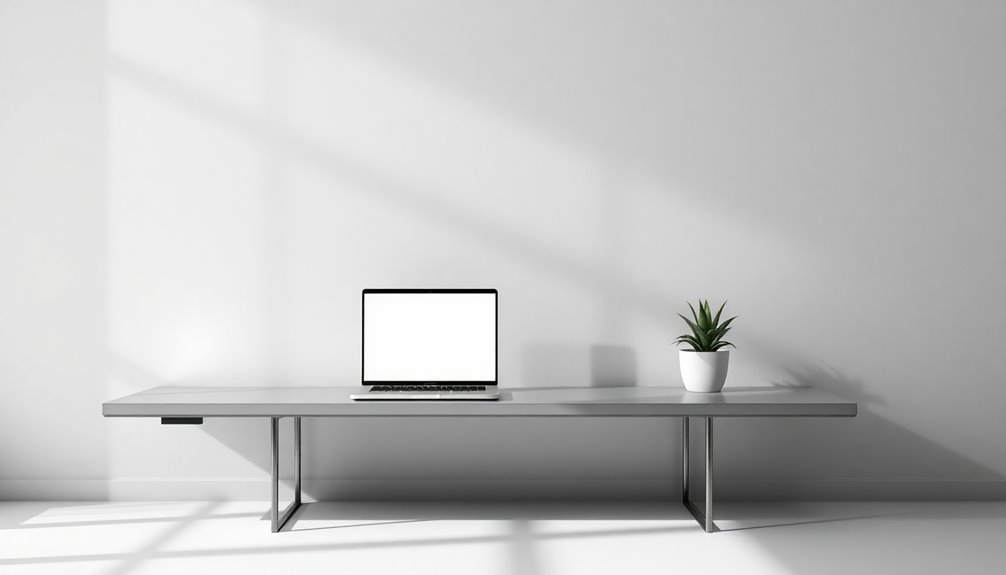
As you explore the future of minimalism in UX design, you'll notice a shift towards richer interfaces that still prioritize simplicity.
Integrating new technologies like haptic feedback and AI-driven personalization will challenge you to balance functionality with emotional resonance.
This evolution will push you to rethink design principles and guarantee that your minimalist approach remains engaging and accessible.
Evolving Design Principles
In envisioning the future of UX design, it's clear that the evolution of minimalism will embrace a warmer, more personalized touch.
As you navigate these changes, expect minimalism to enhance user-centric design by reducing cognitive load and focusing on essential features.
- Haptic feedback will make interactions more engaging.
- Mixed reality will bridge physical and digital experiences.
- AI-driven personalization will tailor experiences to individual preferences.
This balance between simplicity and functional complexity guarantees that minimalist designs remain usable without sacrificing aesthetics.
Technological Integration Challenges
Although the push for minimalism in UX design offers exciting possibilities, it also presents significant technological integration challenges.
You'll need to guarantee that minimalist designs don't sacrifice usability. Excessive simplification can obscure essential features, frustrating users who crave functional depth. As you integrate emerging technologies like AI-driven personalization, it's vital to tailor experiences to diverse user needs while maintaining a clean aesthetic.
Balancing simplicity with deeper connections to user preferences is key. Additionally, as digital devices evolve, your minimalist designs must scale effectively across platforms.
Emphasizing inclusivity also means accounting for various user requirements, assuring clarity and accessibility without compromising on style. Steering through these challenges will shape the future of minimalist UX design, enhancing engagement and user satisfaction.
Frequently Asked Questions
How Does Minimalism Affect User Engagement Metrics?
Minimalism notably impacts user engagement metrics. When you simplify designs, it removes distractions and enhances focus, allowing users to navigate more intuitively.
You'll likely see increased interaction as essential elements stand out. Users appreciate clean layouts, leading to longer session times and higher satisfaction rates.
Additionally, by streamlining content, you encourage quicker decision-making, which can boost conversion rates.
Ultimately, minimalism creates a more enjoyable experience that keeps users coming back.
Can Minimalist Design Be Applied to Mobile Apps Effectively?
Absolutely, you can apply minimalist design to mobile apps effectively.
By focusing on essential features and removing unnecessary elements, you enhance user experience. It helps users navigate easily, reducing cognitive overload.
When you prioritize simplicity, you make interactions smoother, which can lead to higher user satisfaction and retention.
What Industries Benefit Most From Minimalist UX Design?
It's ironic, isn't it? In a world overflowing with choices, less can truly be more.
Industries like tech, fashion, and healthcare thrive on minimalist UX design. When you strip away the clutter, you create a clear path for users, making their experience smoother.
Imagine how much easier it's for a patient to navigate an app or for a shopper to find what they need when distractions fade away.
You're enhancing satisfaction, not complicating it.
How Do Users Generally Perceive Minimalist Interfaces?
When you interact with minimalist interfaces, you likely find them clean and straightforward. Users often appreciate the simplicity, which helps them focus on essential tasks without distractions.
You might feel less overwhelmed by information, leading to a smoother experience. However, some might argue that too much minimalism can leave you wanting more guidance or options.
Are There Any Downsides to Implementing Minimalism in UX?
Sure, you might think minimalism's the holy grail of design—clean, sleek, and oh-so-chic!
But hold on! It can lead to confusion if users can't find what they need. You risk frustrating them with too much white space and not enough guidance.
Plus, some users crave a bit of flair; without it, they might feel lost in a bland digital void.
Conclusion
In a world overflowing with distractions, embracing minimalism in UX design can be a refreshing change. By reducing cognitive load and prioritizing user well-being, you create a space where clarity reigns. As you implement these principles, remember that less truly is more; it's not just about aesthetics, but about crafting meaningful experiences. Let your designs be a sanctuary, inviting users to focus on what matters most and finding joy in simplicity.


